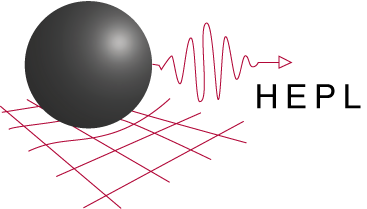News & Events
Dr. Stefan Funk
Assistant Professor, Physics
Stanford University and SLAC
“Gamma-ray astronomy: Status and Future Directions”
Biography: Dr. Funk is an Assistant Professor at Stanford and SLAC. His research interests focus on high energy astrophysics with instruments spanning the energy range from keV X-rays to the highest-energy gamma-rays detected from any astrophysical object with Cherenkov telescopes at up to 100 TeV. A strong focus of his research is connected to the upcoming Gamma-ray Large Area Space Telescope (GLAST-LAT) mission. Major areas of his research in the field of gamma-ray astronomy include: the study of gamma-ray emission from Galactic Particle accelerators such as Supernova remnants or Pulsar Wind Nebulae; understanding particle acceleration in astrophysical objects and the origin of Cosmic rays; identification strategies for Gamma-ray emitters; and the connection between GeV sources and TeV sources.
Prof. Funk is also involved in the instrumentation, design and planning of future international Gamma-ray instruments, and is an associated member of the High Energy Spectroscopic System (H.E.S.S.) collaboration.
Wednesday, January 30, 2008, 4:00 – 5:30 pm
Light refreshments available 4pm; Presentation begins 4:15pm. Open to all.
Other event of interest:
26th Annual Bunyan Lecture
Professor Steve Squyres of Cornell University
Free public lecture:
"Roving Mars: Spirit, Opportunity, and the Exploration of the Red Planet"
Wednesday, February 6, 2008
7:30pm, Hewlett Auditorium room 201
Join our HEPL Seminar Mailing list!
Send an email to majordomo@lists.stanford.edu and type
subscribe heplseminars user@stanford.edu
in the body of the message where user@stanford.edu is your email address
You will receive an email confirmation. We hope to see you at a HEPL Seminar soon.
Previous HEPL Seminars 2004, 2005, 2006, 2007, 2008:
Dr. Stefan Funk
Assistant Professor, Physics,
Stanford University and SLAC
“Gamma-ray astronomy: Status and Future Directions”
Wednesday, January 30, 2008
Dr. Joerg Wagner
University of Stuttgart
“The Origin of the Modern Gyroscope: Bohnenberger's Machine and the Scientific Work of its Inventor”
January 16, 2008
Professor Bob Bingham
Rutherford Appleton Laboratory
“Probing Quantum Gravity Using Matter”
Wednesday, December 12, 2007
Richard N. Boyd
Science Director, National Ignition Facility
Lawrence Livermore National Laboratory
“Creating a Star in the Laboratory: the National Ignition Facility”
Wednesday, November 28, 2007
Domenico Gerardi
Visiting researcher, Hansen Experimental Physics Laboratory, Stanford University
PhD candidate, University of Stuttgart and Science Missions & Systems EADS Astrium
“Achieving disturbance reduction for future drag-free missions. ”
Wednesday, October 24, 2007
Fabio Scardigli
Department of Physics, University of Milano, Italy
"The Equivalence Principle, the Uncertainty Principle and Some Fundamental Physics Questions"
Wednesday, May 23, 2007
Dr. Gregory P. Crawford, Dean of Engineering and Professor of Engineering & Physics
Brown University, Division of Engineering
“In Vivo Spectroscopy for Blood Analyte Monitoring”
Wednesday, April 25, 2007
Professor C.W. Francis Everitt
W.W. Hansen Experimental Physics Laboratory, Stanford University
“Maxwell at 175 ”
Wednesday, March 14, 2007
Paul Brink
Department of Physics, Stanford University speaking for the (Super)CDMS collaboration
“Present status and future plans of the Cryogenic Dark Matter Search (CDMS)”
Wednesday, February 28, 2007
Alfred Vogel
Institute of Biomedical Optics University of Lübeck, Germany
“New findings on plasma and cavity generation in aqueous media with fs and ns laser pulses, and their applications in cell surgery"
Thursday, January 25, 2007
Dr. Dan McCleese
Chief Scientist, Jet Propulsion Laboratory
“Recent Results and Future Direction of the Exploration of Mars"
Tuesday, September 26, 2006
Ned Wright
Professor of Physics and Astronomy, UCLA
What's New in Cosmology?
Thursday 9 March 2006
Peter Michelson
Stanford University
GLAST: The Gamma-ray Large Area Space Telescope Mission
Seminar and Tour
Thursday 16 Feb 2006
Robert L. Byer
Stanford University
"Acceleration of Electrons with Visible Light"
Wednesday 1 Feb 2006
Dr. Nicholas White
Chief,
Laboratory for High Astrophysics NASA Goddard Space Flight Center
“The NASA Beyond Einstein Program”
Wed 5 Oct 2005
Ulrich Schreiber, Forschungseinrichtung Satellitengeodäsie, TU-München
“High Precision Sagnac Interferometry for Applications in Geoscience ”
Thursday, September 8, 2005
Christopher D. Bass,
Indiana University / IUCF, “Measurement of the Parity-Odd Neutron Spin Rotation in Liquid-4He”
Monday, August 22, 2005
Anne Kinney, Director, Universe Division in the Science Mission Directorate, NASA, "Blue Planets, Black Holes"
Wednesday, 20 July 2005
Dr William Tobin, Department of Physics & Astronomy, University of Canterbury, New Zealand, "Foucault's Gyroscope of 1852"
Friday, 8 April 2005
Rex Geveden, NASA Chief Engineer, Independent Technical Authority
7 April 2005
Shooting the Moon: Probing Fundamental Gravity in the Solar System
Tom Murphy,
UC San Diego 3 March 2005
The GRACE Mission: Status and Science Results John Ries, Senior Research Scientist at the Center for Space Research at The University of Texas at Austin, 14 February 2005.
Hubble Robotic Servicing - Recent Engineering Development, Bill Reeve
Civil Space Director of Advanced Science Programs,
Lockheed Martin, 26 January 2005.
Interferometry for LISA, Daniel Shaddock, PhD, Interferometry Metrology and Optics Group, Jet Propulsion Laboratory, 17 November 2004.
The Large Synoptic Survey Telescope (LSST), Steve Kahn, Deputy Director, Kavli Institute for Particle Astrophysics and Cosmology, 27 October 2004.
HEPL-KIPAC Showcase. 29 September 2004. Agenda


